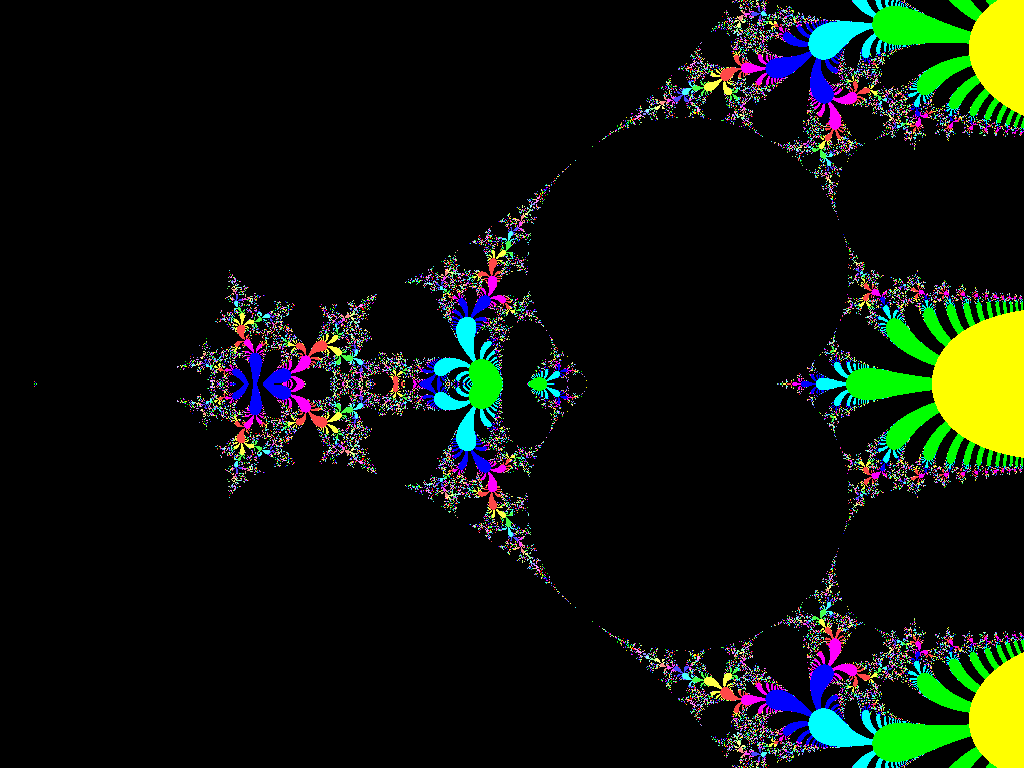The Mandelbrot of exponential map, also known as a tetration fractal for the information it conveys about iterated exponentiation or tetration.

In order to discuss the issue of fractional iteration, the interesting and concrete example of tetration will be reviewed.
Thirty years have passed since I first plotted the tetration fractal. Great strides have been made in mathematics, software, CPU speed and memory. So my current project is to plot a pentation fractal, the Mandelbrot of the tetration map. The mathematics behind the tetration fractal is quite simple; a pentation fractal, not so much. Tetration with real or complex numbers involves the deep subject of fractional iteration in dynamics. Stephen Wolfram suggested that an understanding of complex tetration might be abstracted to handle fractional iteration. This turned out to be true.
Fractional iteration takes on the question, "Do all maps have flows?" This is certainly true for addition, multiplication and exponentiation, but what about tetration and the higher hyperoperators in the Ackermann function? It turns out that the dynamics of the complex plane depends on the type of fixed points - super-attractor which obey Böttcher's functional equation, hyperbolic which can be an attractor or repellor and obeys Schröder functional equation, parabolic where the the Lyapunov multiplier $\lambda=1$ and obeys the Abel functional equation. The Lyapunov multiplier is just the first derivative at the fixed point $p$ where $f'(p)$ is the multiplier. When $|\lambda|=1$ with fixed points can be rationally or irrationally neutral. The rationally neutral can easily be computed from Abel's equation, but the irrationally neutral can have complicated dynamics because of the small divisor problem.
Tetration is as much about iterated logarithms as iterated exponentiation. But logarithms are infinitely multivalued, so in tetration their iteration only complicates this multivalued infinity. This is also true of all iterated transcendental functions.
Note the large black kidney shaped area in the center of the tetration fractal. It's boundary is the Shell-Thron boundary where $|\lambda|=1$.
Tetration period fractal 
This in the opposite of the previous fractal; it displays the period of the orbits that don't escape. The red is period 1, the small yellow disk on the of the left side of the red period 1 is period 2. The green area is period 3 and so on.
There is also two main mathematical approaches to tetration according to Henryk Trappmann. As a matter of esthetics some people focus on tetration where all real numbers map into real numbers. There derivation involves two fixed points with a "crescent" connecting the two fixed points. This approach focuses on numerical calculations because the complicated mathematics used doesn't lend itself to symbolic solutions and software. The following is an exception and addresses for the first time convergence completing the basic theory of extending tetration.
Paulsen and Cowgill's Solving F(z + 1) = b^F(z) in the complex plane and Paulsen's paper Tetration for complex bases .
Complex tetration is where real values get mapped into complex values. It is simpler than the two fixed points approach and lends itself to symbolic solutions.
Geisler Bell Polynomials of Iterated Functions
The attached Mathematica notebook DynDerv3.2 computes hyperbolic iterated functions. It works for all values in the complex plane except if $|\lambda| \ne 1$ or a super-attractor. These exceptions are so sparse in the complex plane that a pentation fractal could be generated only using hyperbolic tetration. Repeated application of fractional iterated functions would allow fractals of higher hyperoperators like pentation and hexation to be generated.
Stephen Wolfram was interested in extending tetration because of what it might tell us about fractional iteration. There are two solid mathematical systems for doing physics, PDE's and iterated functions. The problem is that time in physics appears to be continuous while in iterated functions it appears discrete. Thus is the importance of the work we do here in the context of physics.
Quoting Arnold and Avez, 1968 in E. Lee Jackson's Perspectives of nonlinear dynamics, Vol 1., pg. 51
Let $M$ be a smooth manifold, $\mu$ a measure on $M$ defined by a continuous positive density, $f^t:M \to M$ a one-parameter group of measure-preserving diffeomorphisms. The collection $(M,\mu, f^t)$ is called a classical dynamical system.
See Unifying continuous and discrete physics, Part 2.
 Attachments:
Attachments: